 Space Shuttle Atlantis lifts off on a mission lasting nearly five days, whose primary goal is to lift the interplanetary probe Galileo into orbit. Originally intended for launch in late 1982, Galileo is bound for Jupiter by way of a long, looping trajectory that sends it to Venus and back to Earth multiple times, picking up speed via gravitational assist with each visit. Galileo won’t actually reach Jupiter itself until December 1995. Aboard Atlantis for this flight are Commander Donald Williams, Pilot Michael McCulley, and mission specialists Franklin Chang-Diaz, Shannon Lucid, and Ellen S. Baker.
Space Shuttle Atlantis lifts off on a mission lasting nearly five days, whose primary goal is to lift the interplanetary probe Galileo into orbit. Originally intended for launch in late 1982, Galileo is bound for Jupiter by way of a long, looping trajectory that sends it to Venus and back to Earth multiple times, picking up speed via gravitational assist with each visit. Galileo won’t actually reach Jupiter itself until December 1995. Aboard Atlantis for this flight are Commander Donald Williams, Pilot Michael McCulley, and mission specialists Franklin Chang-Diaz, Shannon Lucid, and Ellen S. Baker.

 The Soviet Union launches the third Mir space station module, Kvant-2, to rendezvous and dock with Mir under automated control. With an airlock to make spacewalks easier, and additional living space and life support, Kvant also includes bathing facilities, water storage and reclamation systems (including a system to collect, detoxify and recycle human urine), and additional scientific equipment.
The Soviet Union launches the third Mir space station module, Kvant-2, to rendezvous and dock with Mir under automated control. With an airlock to make spacewalks easier, and additional living space and life support, Kvant also includes bathing facilities, water storage and reclamation systems (including a system to collect, detoxify and recycle human urine), and additional scientific equipment.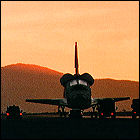 Space Shuttle Discovery lifts off on 1989’s fifth and final shuttle launch, delivering a classified Defense Department payload into orbit on a five-day mission. Aboard Discovery are Commander Frederick Gregory, Pilot John Blaha, and mission specialists Story Musgrave, Manley Carter, and Kathryn Thornton.
Space Shuttle Discovery lifts off on 1989’s fifth and final shuttle launch, delivering a classified Defense Department payload into orbit on a five-day mission. Aboard Discovery are Commander Frederick Gregory, Pilot John Blaha, and mission specialists Story Musgrave, Manley Carter, and Kathryn Thornton. Space Shuttle Columbia lifts off on a ten-day mission to deploy the LEASAT 5 communications satellite and retrieve the Long Duration Exposure Facility satellite that had been placed in orbit in 1984 by Challenger. (LDEF retrieval, delayed from 1985, had been put off by several additional years by the Challenger accident and its aftermath.) Aboard Columbia in this flight are Commander Daniel Brandenstein, Pilot James Wetherbee, and mission specialists Bonnie Dunbar, G. David Low, and Marsha Ivins.
Space Shuttle Columbia lifts off on a ten-day mission to deploy the LEASAT 5 communications satellite and retrieve the Long Duration Exposure Facility satellite that had been placed in orbit in 1984 by Challenger. (LDEF retrieval, delayed from 1985, had been put off by several additional years by the Challenger accident and its aftermath.) Aboard Columbia in this flight are Commander Daniel Brandenstein, Pilot James Wetherbee, and mission specialists Bonnie Dunbar, G. David Low, and Marsha Ivins.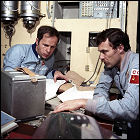 Cosmonauts Anatoly Solovyev and Aleksandr Balandin lift off from the Soviet Union aboard Soyuz TM-9, on their way to a stay aboard the Mir space station. Upon arriving at the station, an inspection of their spacecraft reveals that some of the Soyuz’ thermal blankets detached themselves during launch, though ground controllers decide against such drastic measures as cutting the mission short or launching Soyuz TM-10 early as a rescue mission. Solovyev and Balandin remain aboard Mir for 179 days, greeting the station’s next crew in August and returning to Earth without incident.
Cosmonauts Anatoly Solovyev and Aleksandr Balandin lift off from the Soviet Union aboard Soyuz TM-9, on their way to a stay aboard the Mir space station. Upon arriving at the station, an inspection of their spacecraft reveals that some of the Soyuz’ thermal blankets detached themselves during launch, though ground controllers decide against such drastic measures as cutting the mission short or launching Soyuz TM-10 early as a rescue mission. Solovyev and Balandin remain aboard Mir for 179 days, greeting the station’s next crew in August and returning to Earth without incident.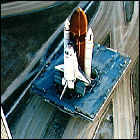 Space Shuttle Atlantis lifts off on a four-day Department of Defense mission, the specifics of which remain classified. The crew consists of Commander John Creighton, Pilot John Casper, and mission specialists Richard Mullane, David Hilmers and Pierre Thuot.
Space Shuttle Atlantis lifts off on a four-day Department of Defense mission, the specifics of which remain classified. The crew consists of Commander John Creighton, Pilot John Casper, and mission specialists Richard Mullane, David Hilmers and Pierre Thuot.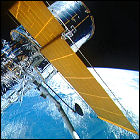 In the planning stages since the 1970s, and delayed by the post-Challenger-disaster downtime for the shuttle program, the Hubble Space Telescope is finally lifted into orbit aboard Space Shuttle Discovery. Hubble is just one of the scientific payloads for the five-day flight, with other experiments being conducted in the crew cabin and the cargo bay. Discovery’s crew for this flight is Commander Loren Shriver, Pilot Charles Bolden, and mission specialists Steven Hawley, Bruce McCandless and Kathryn Sullivan.
In the planning stages since the 1970s, and delayed by the post-Challenger-disaster downtime for the shuttle program, the Hubble Space Telescope is finally lifted into orbit aboard Space Shuttle Discovery. Hubble is just one of the scientific payloads for the five-day flight, with other experiments being conducted in the crew cabin and the cargo bay. Discovery’s crew for this flight is Commander Loren Shriver, Pilot Charles Bolden, and mission specialists Steven Hawley, Bruce McCandless and Kathryn Sullivan.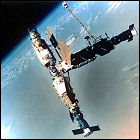 The Soviet Union launches the Kristall module, whose pre-programmed systems bring it to the Mir space station for an automated docking. With facilities for material science experiments, additional gyroscopic stabilizers to keep Mir properly oriented, and other equipment, Kristall also features an extended docking port intended to allow the Soviet-made Buran shuttle to dock at Mir. In time, that docking port will allow a space shuttle to berth at Mir… but not the one its designers anticipate.
The Soviet Union launches the Kristall module, whose pre-programmed systems bring it to the Mir space station for an automated docking. With facilities for material science experiments, additional gyroscopic stabilizers to keep Mir properly oriented, and other equipment, Kristall also features an extended docking port intended to allow the Soviet-made Buran shuttle to dock at Mir. In time, that docking port will allow a space shuttle to berth at Mir… but not the one its designers anticipate.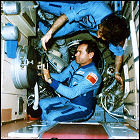 The Soviet Union launches Soyuz TM-10, carrying cosmonauts Gennadi Manakov and Gennady Strekalov to space station Mir for a long-duration stay in orbit. After a 130-day stay aboard Mir, the TM-10 crew returns, bringing with them Japanese TV reporter Toyohiro Akiyama, who would arrive aboard Mir via Soyuz TM-11 in December. Strekalov will return to serve another tour aboard Mir in the 1990s, becoming the first Russian cosmonaut to arrive in a Soyuz and return home in an American space shuttle.
The Soviet Union launches Soyuz TM-10, carrying cosmonauts Gennadi Manakov and Gennady Strekalov to space station Mir for a long-duration stay in orbit. After a 130-day stay aboard Mir, the TM-10 crew returns, bringing with them Japanese TV reporter Toyohiro Akiyama, who would arrive aboard Mir via Soyuz TM-11 in December. Strekalov will return to serve another tour aboard Mir in the 1990s, becoming the first Russian cosmonaut to arrive in a Soyuz and return home in an American space shuttle.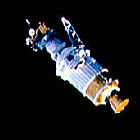 Space Shuttle Discovery lifts off to deliver another space probe whose launch has been delayed in recent years, the Ulysses mission. The remnant of a more elaborate (but ultimately scrapped) International Solar Polar mission, Ulysses is the first and only shuttle payload to use a two-stage booster to launch it from Earth orbit into a high, looping trajectory out of the plane of the ecliptic (roughly corresponding to the sun’s equator, around which the solar system’s planets orbit). Ulysses, built and managed by the European Space Agency, promises the first views of the sun’s polar regions. Discovery’s crew is Commander Richard N. Richards, Pilot Robert Cabana, and mission specialists William Shepherd, Bruce Melnick and Thomas Akers. Discovery lands at Edwards Air Force Base after four days in orbit.
Space Shuttle Discovery lifts off to deliver another space probe whose launch has been delayed in recent years, the Ulysses mission. The remnant of a more elaborate (but ultimately scrapped) International Solar Polar mission, Ulysses is the first and only shuttle payload to use a two-stage booster to launch it from Earth orbit into a high, looping trajectory out of the plane of the ecliptic (roughly corresponding to the sun’s equator, around which the solar system’s planets orbit). Ulysses, built and managed by the European Space Agency, promises the first views of the sun’s polar regions. Discovery’s crew is Commander Richard N. Richards, Pilot Robert Cabana, and mission specialists William Shepherd, Bruce Melnick and Thomas Akers. Discovery lands at Edwards Air Force Base after four days in orbit.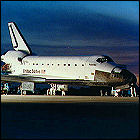 Space Shuttle Atlantis is launched on a mission involving a classified Defense Department payload, staying in Earth orbit for nearly five days. Atlantis’ crew on this flight consists of Commander Richard Covey, Pilot Frank Culbertson, and mission specialists Robert Springer, Carl Meade and Charles Gemar.
Space Shuttle Atlantis is launched on a mission involving a classified Defense Department payload, staying in Earth orbit for nearly five days. Atlantis’ crew on this flight consists of Commander Richard Covey, Pilot Frank Culbertson, and mission specialists Robert Springer, Carl Meade and Charles Gemar.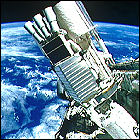 Space Shuttle Columbia lifts off for an eight-day mission to become a manned space telescope in Earth orbit, carrying the ASTRO-1 package designed to conduct X-ray and ultraviolet astronomy, mounted on an unmanned Spacelab pallet in the cargo bay. The mission has been delayed for months, most notably by hydrogen leaks detected long before the original May launch date. Manning Columbia for this flight are Commander Vance Brand, Pilot Guy Gardner, mission specialists Jeffrey Hoffman, John Lounge and Robert Parker, and payload specialists Samuel Durrance and Ronald Parise.
Space Shuttle Columbia lifts off for an eight-day mission to become a manned space telescope in Earth orbit, carrying the ASTRO-1 package designed to conduct X-ray and ultraviolet astronomy, mounted on an unmanned Spacelab pallet in the cargo bay. The mission has been delayed for months, most notably by hydrogen leaks detected long before the original May launch date. Manning Columbia for this flight are Commander Vance Brand, Pilot Guy Gardner, mission specialists Jeffrey Hoffman, John Lounge and Robert Parker, and payload specialists Samuel Durrance and Ronald Parise. 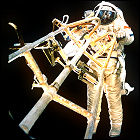 Soyuz TM-11 lifts off from the Baikonur Cosmodrome in the Soviet Union, bound for the space station Mir. Aboard the Soyuz is a crew of three: cosmonauts Viktor Afanasyev and Musa Manarov, with Tokyo Broadcasting System reporter Toyohiro Akiyama, who transmits live reports from Mir for the duration of his week in orbit. (Akiyama will return to Earth with the Soyuz TM-10 crew.) Akiyama is the first space traveler whose seat has been commercially bought and paid for, a flight which ignites the “space tourism” industry built around buying Soyuz seats. Afanasyev and Manarov remain in orbit for 175 days, returning to Earth with British space traveler Helen Sharman in May 1991.
Soyuz TM-11 lifts off from the Baikonur Cosmodrome in the Soviet Union, bound for the space station Mir. Aboard the Soyuz is a crew of three: cosmonauts Viktor Afanasyev and Musa Manarov, with Tokyo Broadcasting System reporter Toyohiro Akiyama, who transmits live reports from Mir for the duration of his week in orbit. (Akiyama will return to Earth with the Soyuz TM-10 crew.) Akiyama is the first space traveler whose seat has been commercially bought and paid for, a flight which ignites the “space tourism” industry built around buying Soyuz seats. Afanasyev and Manarov remain in orbit for 175 days, returning to Earth with British space traveler Helen Sharman in May 1991. The last of the Salyut space stations from the heyday of the Soviet space program, Salyut 7 tumbles into the Earth’s atmosphere, its supply of fuel exhausted. (No cosmonauts have occupied Salyut 7 since 1986.) With the large Kosmos 1686 expansion still docked, most of Salyut 7 disintegrates in the atmosphere, though some debris is scattered over Argentina. Salyut 7 lasted nearly nine years in orbit.
The last of the Salyut space stations from the heyday of the Soviet space program, Salyut 7 tumbles into the Earth’s atmosphere, its supply of fuel exhausted. (No cosmonauts have occupied Salyut 7 since 1986.) With the large Kosmos 1686 expansion still docked, most of Salyut 7 disintegrates in the atmosphere, though some debris is scattered over Argentina. Salyut 7 lasted nearly nine years in orbit.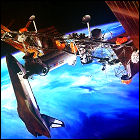 At the insistence of Congress, NASA submits a significant redesign of the long-overdue and over-budget Space Station Freedom for approval. Where previous design changes tried to retain a massive “dual keel” allowing for experiment modules and other activities that could be performed a safe distance away from the station’s habitation modules, the new Space Station Freedom clusters all of its modules together in one place and removes the dual keel structure permanently. Scoffing at the truncated new design, critics refer to the newly-submitted proposal as “Space Station Fred” instead of “Space Station Freedom”.
At the insistence of Congress, NASA submits a significant redesign of the long-overdue and over-budget Space Station Freedom for approval. Where previous design changes tried to retain a massive “dual keel” allowing for experiment modules and other activities that could be performed a safe distance away from the station’s habitation modules, the new Space Station Freedom clusters all of its modules together in one place and removes the dual keel structure permanently. Scoffing at the truncated new design, critics refer to the newly-submitted proposal as “Space Station Fred” instead of “Space Station Freedom”. Space Shuttle Atlantis lifts off on a mission to deploy the orbiting Gamma Ray Observatory satellite. When the high-gain antenna fails to deploy on GRO, the first unplanned spacewalk since 1985 is conducted, with two of the astronauts manually releasing the antenna. Manning Atlantis for nearly six days are Commander Steven Nagel, Pilot Kenneth Cameron, and mission specialists Jerry Ross, Jay Apt and Linda Godwin.
Space Shuttle Atlantis lifts off on a mission to deploy the orbiting Gamma Ray Observatory satellite. When the high-gain antenna fails to deploy on GRO, the first unplanned spacewalk since 1985 is conducted, with two of the astronauts manually releasing the antenna. Manning Atlantis for nearly six days are Commander Steven Nagel, Pilot Kenneth Cameron, and mission specialists Jerry Ross, Jay Apt and Linda Godwin.  Space Shuttle Discovery lifts off on an eight-day mission to delivery both classified and unclassified Defense Department payloads into Earth orbit. Aboard the shuttle for this flight are Commander Michael Coats, Pilot Blaine Hammond, and mission specialists Guion Bluford, Gregory Harbaugh, Richard Hieb, Donald McMonagle and Charles Veach.
Space Shuttle Discovery lifts off on an eight-day mission to delivery both classified and unclassified Defense Department payloads into Earth orbit. Aboard the shuttle for this flight are Commander Michael Coats, Pilot Blaine Hammond, and mission specialists Guion Bluford, Gregory Harbaugh, Richard Hieb, Donald McMonagle and Charles Veach. Helen Sharman becomes the first British national in space, flying aboard Soyuz TM-12 to the Soviet space station Mir. Making her flight in a seat bought and paid for by a consortium of British commercial interests, Sharman tags along with cosmonauts Anatoly Artsebarsky and Sergei Krikalev, and she spends just a week in orbit before returning with Soyuz TM-13 cosmonaut Toktar Aubakirov. Artsebarsky and Krikalev remain aboard Mir for what is initially planned to be a five-month stay, though a shake-up in the flight schedule forces mission planners to ask Krikalev to stay aboard Mir even after Artsebarsky returns to Earth, resulting in Krikalev remaining on Mir for 10 months, not returning home until 1992 – at which point the Soviet Union will have ceased to exist.
Helen Sharman becomes the first British national in space, flying aboard Soyuz TM-12 to the Soviet space station Mir. Making her flight in a seat bought and paid for by a consortium of British commercial interests, Sharman tags along with cosmonauts Anatoly Artsebarsky and Sergei Krikalev, and she spends just a week in orbit before returning with Soyuz TM-13 cosmonaut Toktar Aubakirov. Artsebarsky and Krikalev remain aboard Mir for what is initially planned to be a five-month stay, though a shake-up in the flight schedule forces mission planners to ask Krikalev to stay aboard Mir even after Artsebarsky returns to Earth, resulting in Krikalev remaining on Mir for 10 months, not returning home until 1992 – at which point the Soviet Union will have ceased to exist. Space Shuttle Columbia lifts off on a nine-day mission with – for the first time in the shuttle program – a crew that’s nearly 50% female. Columbia carries the Spacelab module into orbit for a series of life sciences and biology experiments, the first flight devoted to such experiments since the Skylab era. Aboard Columbia for this flight are Commander Bryan O’Connor, Pilot Sidney Gutierrez, and mission specialists James Bagian, Tamara Jernigan, Rhea Seddon, Drew Gaffney and Millie Hughes-Fulford.
Space Shuttle Columbia lifts off on a nine-day mission with – for the first time in the shuttle program – a crew that’s nearly 50% female. Columbia carries the Spacelab module into orbit for a series of life sciences and biology experiments, the first flight devoted to such experiments since the Skylab era. Aboard Columbia for this flight are Commander Bryan O’Connor, Pilot Sidney Gutierrez, and mission specialists James Bagian, Tamara Jernigan, Rhea Seddon, Drew Gaffney and Millie Hughes-Fulford. NASA launches Space Shuttle Atlantis on a satellite deployment and science mission lasting nearly nine days. The fourth TDRS (Tracking & Data Relay Satellite) is launched, and several experiments are performed on board, including materials processing experiments. Atlantis’ crew consists of Commander John Blaha, Pilot Michael Baker, and mission specialists Shannon Lucid, James Adamson and David Low.
NASA launches Space Shuttle Atlantis on a satellite deployment and science mission lasting nearly nine days. The fourth TDRS (Tracking & Data Relay Satellite) is launched, and several experiments are performed on board, including materials processing experiments. Atlantis’ crew consists of Commander John Blaha, Pilot Michael Baker, and mission specialists Shannon Lucid, James Adamson and David Low.  Space Shuttle Discovery lifts off on a five-day mission to deliver the Upper Atmosphere Research Satellite (UARS) into a low Earth orbit, where the satellite spends over a year studying the outer layers of Earth’s atmosphere. UARS also focuses on study of Earth’s ozone layer. Other experiments are carried out aboard the orbiter by Commander John Creighton, Pilot Kenneth Reightler, , and mission specialists Mark Brown, Charles Gemar and James Buchli.
Space Shuttle Discovery lifts off on a five-day mission to deliver the Upper Atmosphere Research Satellite (UARS) into a low Earth orbit, where the satellite spends over a year studying the outer layers of Earth’s atmosphere. UARS also focuses on study of Earth’s ozone layer. Other experiments are carried out aboard the orbiter by Commander John Creighton, Pilot Kenneth Reightler, , and mission specialists Mark Brown, Charles Gemar and James Buchli.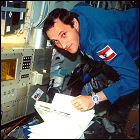 The Soviet Union launches its last space mission, Soyuz TM-13, carrying cosmonauts Alexander Volkov, Toktar Aubakirov and the first Austrian in space, Franz Viehböck, to space station Mir. After a week in space, Aubakirov and Viehböck return to Earth aboard Soyuz TM-12 with incumbent station crewmember Anatoly Artsebarksky, while Volkov stays for 175 days (alongside Krikalev, who will have been in space for 10 months by the time he returns to Earth in 1992). During Volkov and Krikalev’s stay aboard Mir, the Soviet Union collapses; they instead return to Earth as Russian citizens.
The Soviet Union launches its last space mission, Soyuz TM-13, carrying cosmonauts Alexander Volkov, Toktar Aubakirov and the first Austrian in space, Franz Viehböck, to space station Mir. After a week in space, Aubakirov and Viehböck return to Earth aboard Soyuz TM-12 with incumbent station crewmember Anatoly Artsebarksky, while Volkov stays for 175 days (alongside Krikalev, who will have been in space for 10 months by the time he returns to Earth in 1992). During Volkov and Krikalev’s stay aboard Mir, the Soviet Union collapses; they instead return to Earth as Russian citizens. NASA launches Space Shuttle Atlantis on a mission lasting nearly a week, deploying both classified and unclassified payloads for the Defense Department. After the payload deployments, tests are conducted to determine the viability of the shuttle orbiters for long-duration missions. Manning Atlantis for this mission are Commander Frederick Gregory, Pilot Terence Henricks, and mission specialists Mario Runco, James Voss, Story Musgrave and Thomas Hennen.
NASA launches Space Shuttle Atlantis on a mission lasting nearly a week, deploying both classified and unclassified payloads for the Defense Department. After the payload deployments, tests are conducted to determine the viability of the shuttle orbiters for long-duration missions. Manning Atlantis for this mission are Commander Frederick Gregory, Pilot Terence Henricks, and mission specialists Mario Runco, James Voss, Story Musgrave and Thomas Hennen.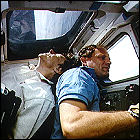 Space Shuttle Discovery lifts off for an eight day Spacelab mission, with an multi-national crew participating in “IML-1” (International Microgravity Laboratory) experiments. Discovery’s crew for this flight consists of Commander Ronald Grabe, Pilot Stephen Oswald, mission specialists Norman Thagard, David Hilmers, and William Readdy, and payload specialists Roberta Bondar and Ulf Merbold.
Space Shuttle Discovery lifts off for an eight day Spacelab mission, with an multi-national crew participating in “IML-1” (International Microgravity Laboratory) experiments. Discovery’s crew for this flight consists of Commander Ronald Grabe, Pilot Stephen Oswald, mission specialists Norman Thagard, David Hilmers, and William Readdy, and payload specialists Roberta Bondar and Ulf Merbold. 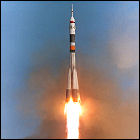 Soyuz TM-14 lifts off from the Baikonur Cosmodrome in Kazakhstan, the first space mission from post-Soviet Russia. It carries cosmonauts Alexander Viktorenko, Alexander Kaleri, and Klaus-Dietrich Flade to space station Mir. Viktorenko and Kaleri remain aboard Mir for 145 days, while Flade returns to Earth with the previous station crew aboard Soyuz TM-13. When TM-14 returns to Earth in August 1992, Viktorenko and Kaleri suffer an unusual landing, with their descent module rolling to an upside-down position, trapping the cosmonauts inside until rescue crews arrive.
Soyuz TM-14 lifts off from the Baikonur Cosmodrome in Kazakhstan, the first space mission from post-Soviet Russia. It carries cosmonauts Alexander Viktorenko, Alexander Kaleri, and Klaus-Dietrich Flade to space station Mir. Viktorenko and Kaleri remain aboard Mir for 145 days, while Flade returns to Earth with the previous station crew aboard Soyuz TM-13. When TM-14 returns to Earth in August 1992, Viktorenko and Kaleri suffer an unusual landing, with their descent module rolling to an upside-down position, trapping the cosmonauts inside until rescue crews arrive.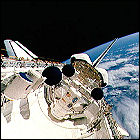 NASA launches Space Shuttle Atlantis on the 46th shuttle mission, carrying the Spacelab-based ATLAS (Atmospheric Laboratory for Applications and Science) experiment module. Aboard Atlantis for the nearly-nine-day flight are Commander Charles Bolden, Pilot Brian Duffy, Payload Commander Kathyrn Sullivan, mission specialists David Leestma and Michael Foale, and payload specialists Byron Lichtenberg and Dirk Frimout. NASA extends the mission by one day to accomodate additional experiments.
NASA launches Space Shuttle Atlantis on the 46th shuttle mission, carrying the Spacelab-based ATLAS (Atmospheric Laboratory for Applications and Science) experiment module. Aboard Atlantis for the nearly-nine-day flight are Commander Charles Bolden, Pilot Brian Duffy, Payload Commander Kathyrn Sullivan, mission specialists David Leestma and Michael Foale, and payload specialists Byron Lichtenberg and Dirk Frimout. NASA extends the mission by one day to accomodate additional experiments.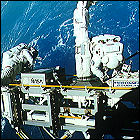 Space Shuttle Endeavour leaves Earth for the first time, carrying a crew of seven to orbit on the 47th shuttle mission. Over nearly nine days, three spacewalks are taken up with the tricky and dangerous task of capturing a four-and-a-half-ton communications satellite into Endeavour’s cargo bay to repair and relaunch it. (The satellite, Intelsat VI, had been stranded in the wrong orbit since its 1990 launch aboard a Titan rocket.) The record-setting spacewalks involved – each lasting over seven hours and marking the first time three astronauts have operated outside their vehicle – force NASA to cancel one of two experimental EVAs to test space station construction techniques. Endeavour’s first crew consists of Commander Daniel Brandenstein, pilot Kevin Chilton, and mission specialists Pierre Thuot, Kathryn Thornton, Richard Hieb, Thomas Akers and Bruce Melnick.
Space Shuttle Endeavour leaves Earth for the first time, carrying a crew of seven to orbit on the 47th shuttle mission. Over nearly nine days, three spacewalks are taken up with the tricky and dangerous task of capturing a four-and-a-half-ton communications satellite into Endeavour’s cargo bay to repair and relaunch it. (The satellite, Intelsat VI, had been stranded in the wrong orbit since its 1990 launch aboard a Titan rocket.) The record-setting spacewalks involved – each lasting over seven hours and marking the first time three astronauts have operated outside their vehicle – force NASA to cancel one of two experimental EVAs to test space station construction techniques. Endeavour’s first crew consists of Commander Daniel Brandenstein, pilot Kevin Chilton, and mission specialists Pierre Thuot, Kathryn Thornton, Richard Hieb, Thomas Akers and Bruce Melnick.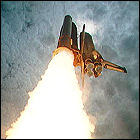 NASA launches Space Shuttle Columbia on the 48th shuttle mission (Columbia’s 12th trip into orbit). Using the Spacelab module, Columbia’s crew conducted the first USML (United States Microgravity Laboratory) flight, as well as testing a new system called the EDO (Extended Duration Orbiter) package, allowing the crew to stay in orbit longer than any previous shuttle (or, for that matter, lunar) flight. Aboard Columbia for the record-breaking 13-and-a-half-day mission are Commander Richard N. Richards, Pilot Ken Bowersox, Payload Commander Bonnie Dunbar, mission specialists Ellen Baker and Carl Meade, and payload specialists Lawrence DeLucasand Eugene Trinh.
NASA launches Space Shuttle Columbia on the 48th shuttle mission (Columbia’s 12th trip into orbit). Using the Spacelab module, Columbia’s crew conducted the first USML (United States Microgravity Laboratory) flight, as well as testing a new system called the EDO (Extended Duration Orbiter) package, allowing the crew to stay in orbit longer than any previous shuttle (or, for that matter, lunar) flight. Aboard Columbia for the record-breaking 13-and-a-half-day mission are Commander Richard N. Richards, Pilot Ken Bowersox, Payload Commander Bonnie Dunbar, mission specialists Ellen Baker and Carl Meade, and payload specialists Lawrence DeLucasand Eugene Trinh.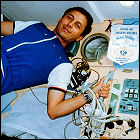 The Russian spacecraft Soyuz TM-15 lifts off from Kazakhstan, carrying cosmonauts Anatoly Solovyev and Sergei Avdeyev, along with French spationaut Michel Tognini, to space station Mir. Tognini remains aboard Mir for two weeks, returning with the Soyuz TM-14 crew, while Solovyev and Avdeyev are aboard for the long haul, manning Mir for 188 days before returning to Earth early in 1993.
The Russian spacecraft Soyuz TM-15 lifts off from Kazakhstan, carrying cosmonauts Anatoly Solovyev and Sergei Avdeyev, along with French spationaut Michel Tognini, to space station Mir. Tognini remains aboard Mir for two weeks, returning with the Soyuz TM-14 crew, while Solovyev and Avdeyev are aboard for the long haul, manning Mir for 188 days before returning to Earth early in 1993.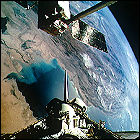 Space Shuttle Atlantis is launched on an eight-day mission to deploy two experiment packages developed jointly with the European and Italian space agencies. (The mission is extended by a day to accomodate more experiments.) Aboard Atlantis for her 12th flight are Commander Loren Shriver, Pilot Andrew Allen, mission specialists Jeffrey Hoffman, Franklin Chang-Diaz, Claude Nicollier and Marsha Ivins, and payload specialist Franco Malerba.
Space Shuttle Atlantis is launched on an eight-day mission to deploy two experiment packages developed jointly with the European and Italian space agencies. (The mission is extended by a day to accomodate more experiments.) Aboard Atlantis for her 12th flight are Commander Loren Shriver, Pilot Andrew Allen, mission specialists Jeffrey Hoffman, Franklin Chang-Diaz, Claude Nicollier and Marsha Ivins, and payload specialist Franco Malerba.